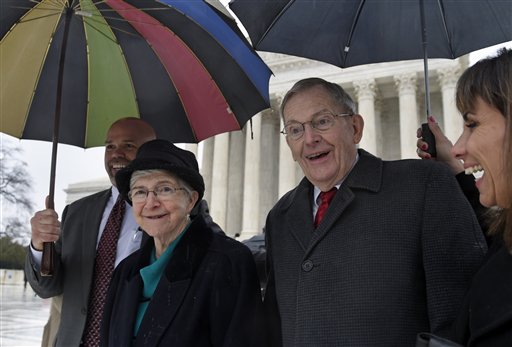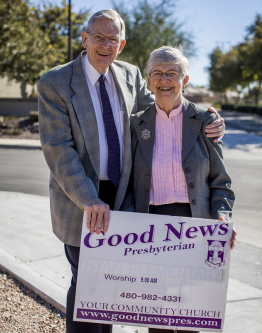In Reed v. Town of Gilbert, the U.S. Supreme Court, 135 S.Ct. 2218 (2015), unanimously invalidated an ordinance that treated signs differently based on their content.
The Court’s majority opinion reaffirmed the vitality of the content-discrimination principle as an animating principle of First Amendment law.
While all the justices agreed the ordinance was unconstitutional, they disagreed significantly over how expansively to apply the content-discrimination principle.
Arizona town put size, time limits on directional signs
In Arizona, the town of Gilbert’s ordinance imposed far more restrictions on “Temporary Directional Signs Related to a Qualifying Event” than on “Ideological Signs” or “Political Signs.” The temporary directional signs could be no more than 6 square feet and could be displayed only 12 hours before and one hour after the qualifying event.
Pastor Clyde Reed of the Good News Community Church posted signs indicating the times of church services. The church did not own its own building and met at elementary schools and other locations around town. The town’s sign code compliance manager cited the Church for violating the sign code. Reed had unsuccessfully tried to reach an accommodation with the Town’s Sign Code Compliance Department.
Pastor who posted church signs challenged ordinance on First Amendment grounds
He then sued in federal district court, alleging First Amendment violations. The federal district court granted summary judgment for the town, a decision affirmed by the Ninth U.S. Circuit Court of Appeals. The Ninth Circuit deemed the sign ordinance content-neutral because town officials did not adopt the ordinance because they disagreed with the content on any particular signs.
The U.S. Supreme Court reversed, finding that the town’s sign ordinance was patently unconstitutional.
The Court first determined that the sign code was content-based, not content-neutral. In his majority opinion, Justice Clarence Thomas reasoned that the law was content-based on its face, because it treated signs differently.
“The restrictions in the Sign Code that apply to any given sign thus depend entirely on the communicative content of the sign,” Thomas explained. He rejected the Ninth Circuit’s reasoning that the law was content-neutral because there was no underlying purpose to discriminate against particular messages. “In other words, an innocuous justification cannot transform a facially content-based law into one that is content-neutral.”

Good News Community Church Pastor Clyde Reed, center, smiles as he leaves the Supreme Court in 2015, with his wife Ann, left. The Court sided with the small church in its fight over limits on roadside signs directing people to Sunday services. Liberal and conservative justices expressed misgivings with the sign ordinance because it places more restrictions on the churches’ temporary signs than those erected by political candidates, real estate agents and others. (AP Photo/Susan Walsh, used with permission from the Associate Press)
Supreme Court: Sign restrictions based on content violates First Amendment
Thomas also reiterated a message the Court articulated in Chicago Police Dept. v. Mosley (1972) – that laws are content-based when they restrict speech based on subject matter. He also explained that laws can be content-based even if they are viewpoint neutral. In other words, viewpoint discrimination merely is a subset of content discrimination.
Because the ordinance was content-based, Thomas evaluated the ordinance under strict scrutiny.
The town had offered two justifications for its law: aesthetics and traffic safety. Thomas assumed that the ordinance furthered these compelling governmental interests, but said that the ordinance was “hopelessly underinclusive” because all types of signs can cause visual clutter and impact traffic safety. “The Town has offered no reason to believe that directional signs pose a greater threat to safety than do ideological or political signs,” Thomas wrote. “If anything, a sharply worded ideological sign seems more likely to distract a driver than a sign directing the public to a nearby church meeting.”
Justices differed on what might be reasonable sign regulations
Justice Samuel Alito wrote a concurring opinion, stressing that cities could still enact “reasonable sign regulations.” He listed a series of restrictions on signs that he felt were permissible and content-neutral.
Justice Stephen Breyer also wrote a concurring opinion, questioning the rigid application of the content discrimination principle. He reasoned that the rule should be a “rule of thumb” rather than an “automatic strict scrutiny trigger.”
Justice Elena Kagan also wrote a concurring opinion, but she disagreed sharply with Thomas’ analysis. She warned that Thomas’ opinion called into question sign ordinances across the country. She said that strict scrutiny should be applied when there is a danger of illegitimate governmental purpose, not rigidly to any law that draws any content distinctions.
The Court’s decision in Reed v. Town of Gilbert has had a palpable impact on First Amendment jurisprudence. Lower courts have relied on the decision in invalidating sign ordinances, panhandling regulations, and an assortment of other laws.
David L. Hudson, Jr. is a law professor at Belmont who publishes widely on First Amendment topics. He is the author of a 12-lecture audio course on the First Amendment entitled Freedom of Speech: Understanding the First Amendment (Now You Know Media, 2018). He also is the author of many First Amendment books, including The First Amendment: Freedom of Speech (Thomson Reuters, 2012) and Freedom of Speech: Documents Decoded (ABC-CLIO, 2017). This article was originally published in 2017.

